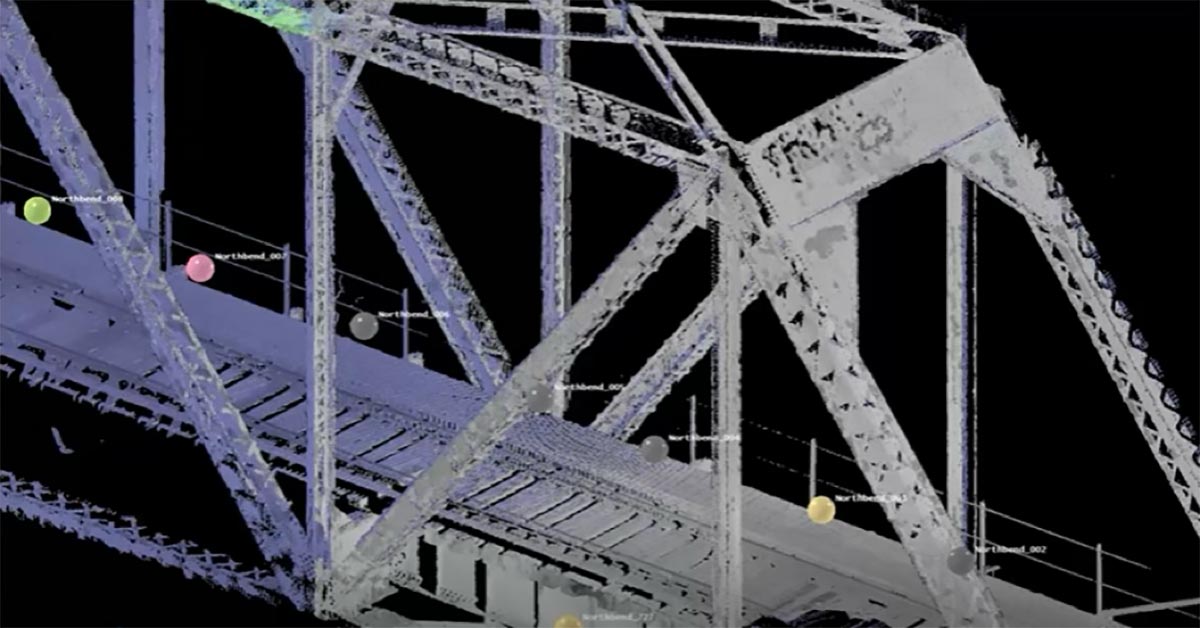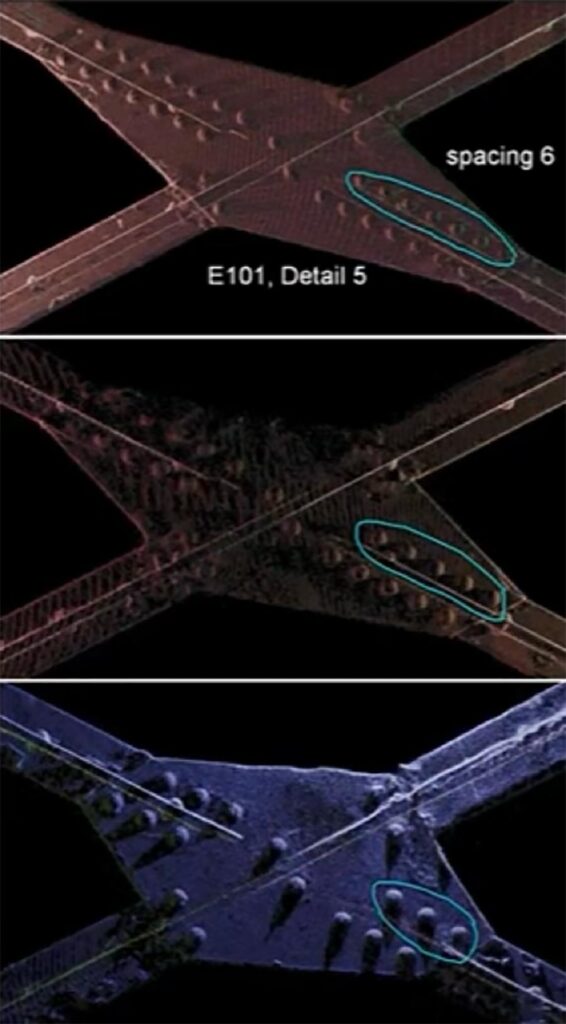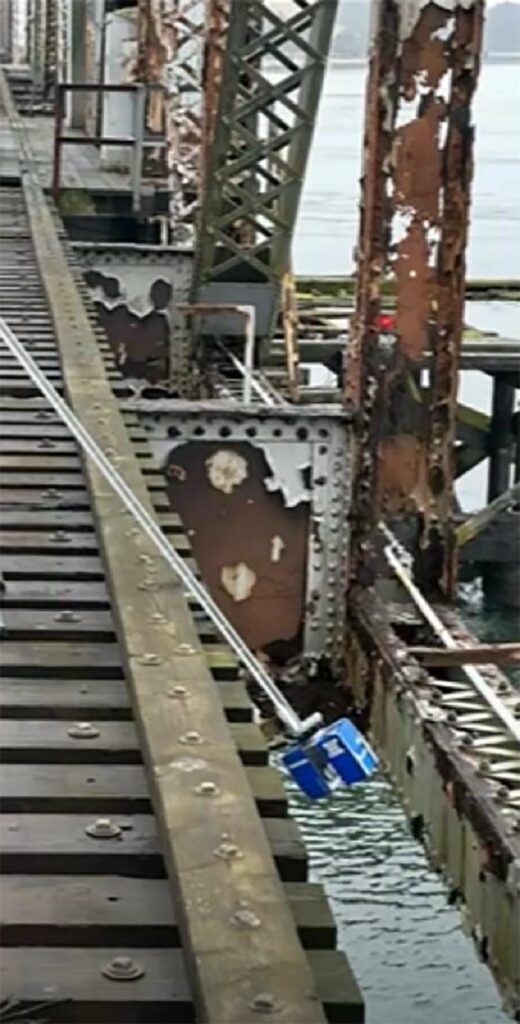Revolutionizing Bridge Restoration

Rainier Welding, Summit Engineering and Design (SEAD), and Legacy Contracting team up to solve a complex bridge restoration project combining 3D scanning technology with bridge building expertise.
10,000+ replacement parts
45,000+ bolts
835,000+ pounds of steel
The Complexity of the Project: An Aging Structure and Incomplete Data
The Coos Bay Rail Line bridge, originally built in 1914, presented numerous challenges for restoration. The existing field drawings lacked precise measurements, requiring all structural details to be field verified. Complicating matters, the bridge’s rivet holes could not be precisely located, as rivets tend to shift slightly during installation, making direct measurement impossible. Furthermore, environmental regulations prevented crews from cleaning debris and corrosion from the bridge, limiting visibility and increasing the difficulty of collecting accurate measurements.
What do you do with poor drawings when each drawing requires “field verify”? Historical methods are insufficient.
The Challenge: From Field Drawings to Precision Fabrication
Replacing steel bridge components often involves manual field verification, where workers create balsa wood or plywood templates to match the dimensions of the original structural components. These methods were not only time-consuming but also prone to errors, leading to costly rework when fabricated parts failed to fit properly.
For the Coos Bay Rail Line bridge, the original field drawings provided by Stantec identified only the steel members requiring replacement but did not include precise measurements or existing structural conditions. This meant fabricators like Rainier Welding had to find a more accurate way to produce components that would fit seamlessly during a challenging installation.
The Solution: 3D Scanning for Precision Replication
Rainier Welding partnered with SEAD to integrate advanced 3D laser scanning technology, which provided highly detailed, millimeter-accurate scans of the existing bridge structure. This approach eliminated the guesswork of traditional template methods by capturing the exact dimensions of the steel members being replaced.
How 3D Scanning Transformed the Process
-
- Eliminated Manual Templates: 3D scans replaced field-made templates, reducing human error.
- Captured Rivet & Bolt Patterns: Scans identified general rivet locations and structural variations in the original bridge. The precise dimensions and bolt patters required SEAD’s software and expert analysis, and lots of math!
- Created Digital Replicas: Using Scan-to-Plan™ technology, SEAD converted scan data into highly accurate 3D models, ensuring fabricated components would fit precisely.
- Streamlined Fabrication: Rainier Welding, from 500 miles away, used the digital scan data to accurately detail and fabricate replacement components before arriving on-site, drastically reducing installation time. Parts could be painted and numerically identified, ready to install.

Rainier Welding’s Role in Modernizing Bridge Fabrication
As the primary steel fabricator for the Historical Coos Bay Rail Line Bridge, Rainier Welding leveraged SEAD’s scanning technology to ensure replacement steel members were identical to the originals, eliminating costly delays from misaligned parts.
By incorporating 3D scans into its workflow, Rainier Welding was able to:
-
- Improve fabrication accuracy—ensuring parts were within millimeter tolerances.
- Reduce rework and material waste—cutting costs and improving efficiency.
- Accelerate project timelines—allowing installation crews to complete work faster and with fewer modifications.
- Provide accurate drawings for future maintenance and monitoring.
This method has now set a new industry standard for bridge rehabilitation projects, proving that precise fabrication starts with accurate field data.
How SEAD’s Technology Enhanced Field Verification
SEAD’s 3D scanning solutions provided Rainier Welding with data-rich models that went beyond simple replacement drawings. Traditional methods required field crews to create templates manually—a process that often introduced subtle but significant inaccuracies. Most importantly, remotely placing scanners is far safer than hands on measurements when access is challenging or exposed.
Advantages of SEAD’s 3D Scanning in This Project
-
- Captured Historic Structural Variations: Many bridge components, originally built in the early 1900s, exhibited rivet misalignments and inconsistencies that 3D scanning accurately documented.
- Provided High-Fidelity CAD Models: Instead of approximations, engineers and fabricators worked with exact digital replicas of each component.
- Seamless Integration with Fabrication Software: Rainier Welding used SEAD’s scan data in CAD and CNC programming, ensuring precision manufacturing of steel components.

A Game-Changer for Bridge Restoration Projects
The partnership between Rainier Welding and SEAD on the Coos Bay Rail Line bridge exemplifies the future of bridge rehabilitation and steel fabrication. By replacing balsa wood templates with 3D scan data, this project demonstrated how modern technology can:
✅ Eliminate guesswork—ensuring replacement components fit perfectly the first time.
✅ Reduce field labor—minimizing time-consuming and error-prone manual measurements.
✅ Optimize fabrication efficiency—allowing steel fabricators to work with the most accurate data available.
✅ Enhance long-term structural integrity—preserving bridges while reducing future maintenance costs.
By integrating 3D scanning and digital modeling, bridge rehabilitation projects can now achieve unmatched levels of accuracy and efficiency, setting a new industry benchmark.
Final Thoughts: Setting the Standard for Future Projects
The Coos Bay Rail Line bridge replacement is a testament to the transformative power of technology in bridge restoration. By embracing 3D scanning technology, Rainier Welding and SEAD have redefined the standard for steel fabrication in infrastructure projects. The shift from manual templates to digital precision is not just an improvement—it’s a necessity for modern engineering.
As more bridge rehabilitation projects recognize the benefits of integrating 3D scanning into fabrication, Rainier Welding and SEAD’s team approach will undoubtedly become the gold standard for precision steel replication.
Please Contact Us if you would like to learn more about this project or its potential application your bridge restoration project.
